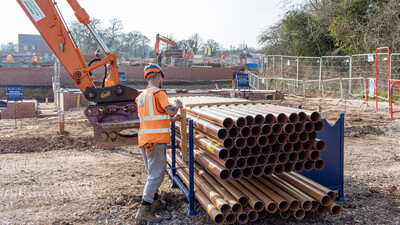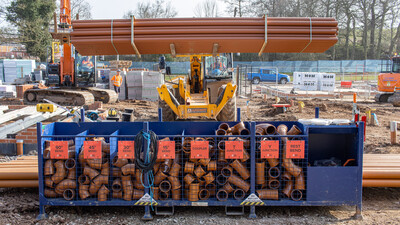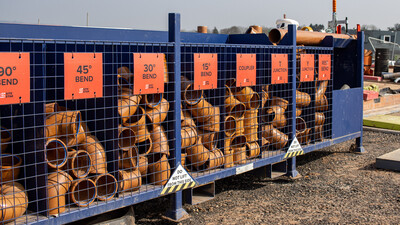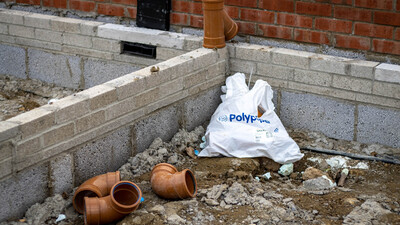As with all brands of PVCu drainage pipes and fittings, a lack of adequate storage solutions often lead to damage or misplaced materials.
Handling and loading of pipes
Polypipe supplies plastic drainage pipes in bundles secured within timber frames. 110mm pipes come in a pack of fifty, and 160mm ones come in a quantity of thirty-five.
According to Polypipes's installation guide:
"Loose pipes should be loaded onto transport and unloaded by hand, however for mechanical unloading, webbing or rope slings should be used. Metal chains, hooks or chains must not come into contact with pipes. Pipes in larger quantities may be delivered in full bundles within timber frames and the pipes should remain within this packaging until required for installation. Pipe bundles should be unloaded by using webbing or rope slings or by forklift. If unloading by forklift, care should be taken to align forks correctly underneath the bundles to avoid damage to the pipes."
The handling of bulk drainage doesn’t normally cause too much of a problem on construction sites where forklifts can quickly and easily place the drainage into the material storage compound. Once the drainage needs to be installed and taken out onto the site, however, problems with storage and material handling can quickly become apparent.
Storage of loose pipes
The best way to handle drainage pipes and fittings once they are ready to be used on-site is to use a SiteStak workstation. If you have an extra-wide version, these allow you to forklift a complete bundle of pipes to the pipe storage section. Once you remove the wooden supports and banding straps, the SiteStak workstation will safely store the pipes within its uprights.


How to store drainage fittings and bends
Typically supplied in plastic bags or boxes, drainage fittings can soon end up being misplaced. It is also time-consuming to search through the many different bags to find the fittings that are needed. To help resolve this on site we have included separate compartments for each fitting and include clear signs indicating what is to be placed within. This allows you to keep track of how much stock you have left and you can see at a glance when you are running low or have run out. It also speeds up drainage installation, by cutting down the time that used to be spent searching through the bags. Now you can see what you need instantly.


Correct cutting and chamfering of pipes
We have covered in detail before how to cut and chamfer drainage pipes. It is important to make sure you get a straight cut and chamfer the edges of the cut end to make sure they don’t damage the seal when applying a fitting.
Methods of connecting pipes
The most widely used method of jointing is called push-fit jointing.
- If you are using a plain-ended pipe, ensure that the pipe is cut square and that all burrs are removed. Using the SiteStak saw guide ensures a straight cut every time.
- Chamfer the end of the pipe to prevent the ring seal from being damaged when the pipe is inserted into the socket. Fittings with spigot ends are moulded with a chamfer during manufacture.
- Lubricate the spigot or ring seal with pipe lubricant
- Insert the pipe or fitting into the socket and then withdraw it by approx. 10mm to allow for thermal expansion and contraction of the pipework.
We hope this guide has been helpful in demonstrating how to store, transport and work with Polypipe below-ground drainage.

Written by
Mark Chambers
Marketing Manager
As Marketing Manager, Mark plays an active role in running strategic projects to increase our brand profile.



